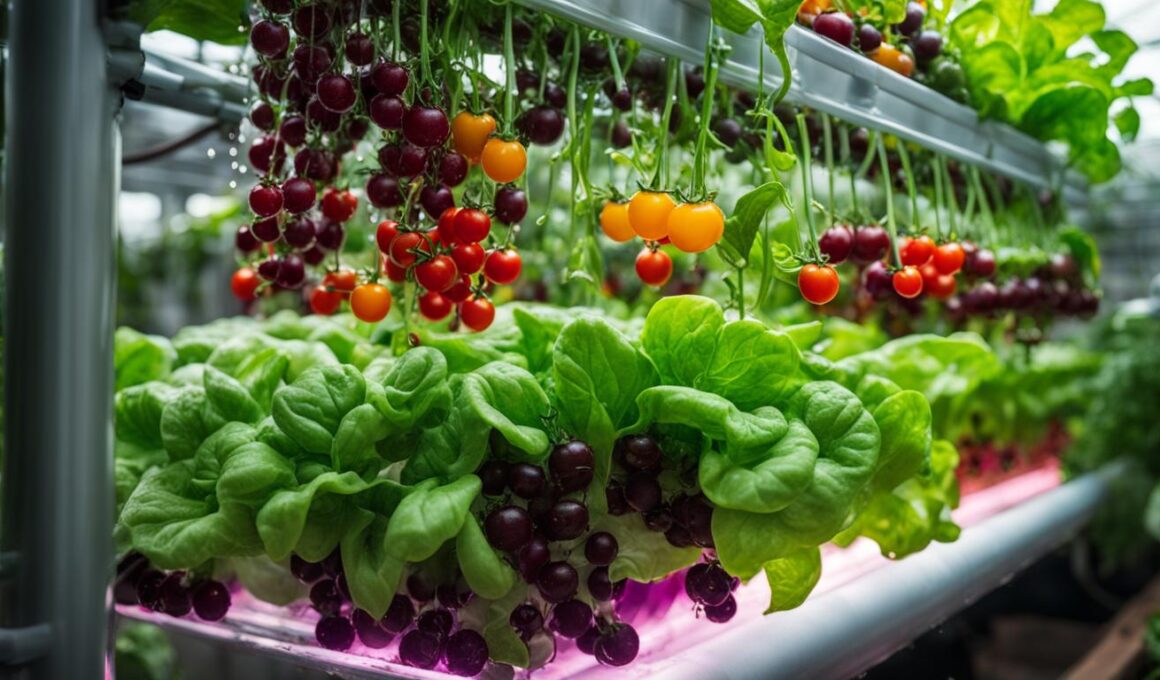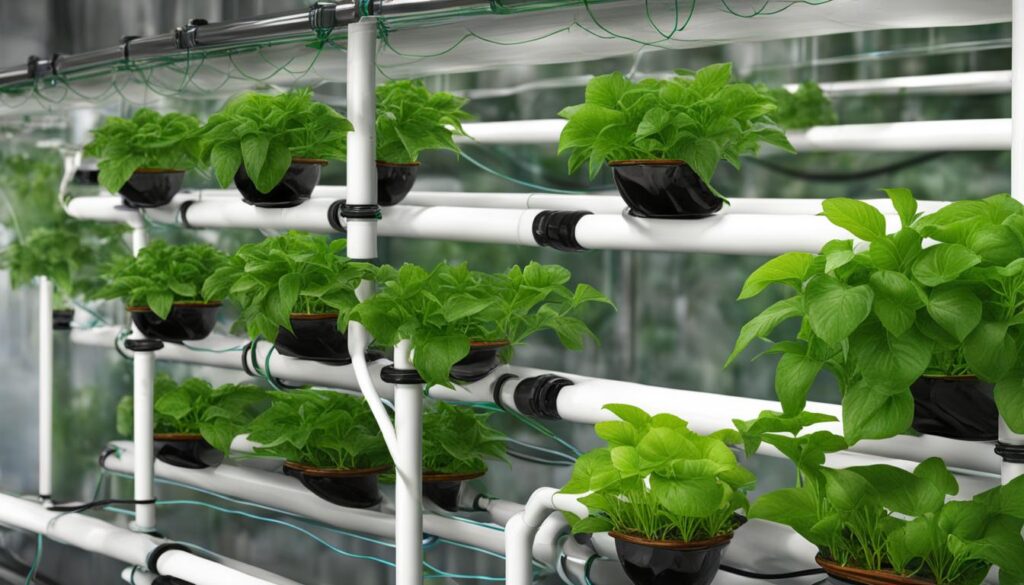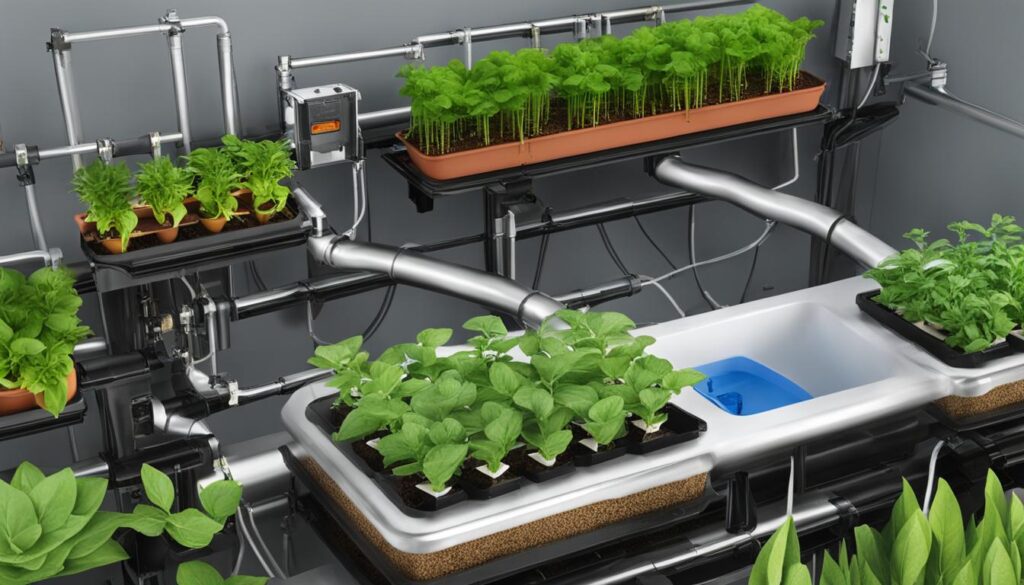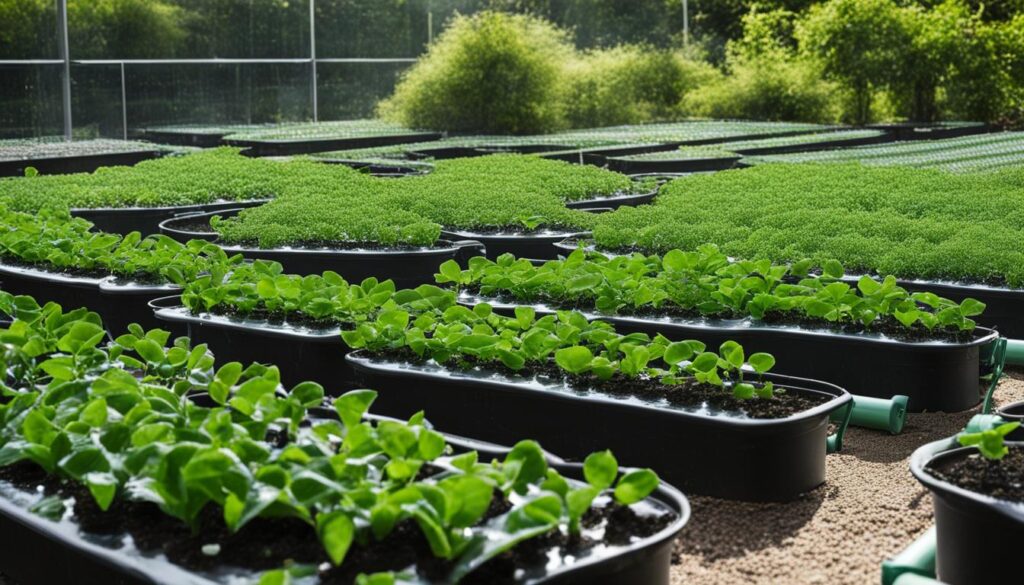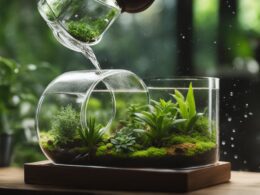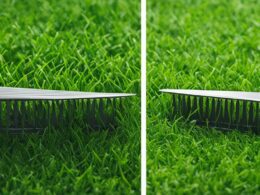A drip system is a popular and commercially viable option in the world of hydroponics. It uses small emitters to drip nutrient solution directly onto plants, offering precise control over water and nutrient supply. The system can be set up with individual pots for plants and uses a pump to deliver water and nutrients through a network of tubing. There are two main variations of the drip system – recirculating and non-recovery – each with its own advantages and disadvantages.
Post Summary
- Drip system hydroponics provides precise control over water and nutrient supply.
- It can be set up with individual pots for plants.
- There are two main variations of the drip system – recirculating and non-recovery.
- Recirculating systems are more water and nutrient efficient but require regular maintenance.
- Non-recovery systems allow excess water to run off as waste, reducing maintenance of the reservoir.
Drip systems use small emitters to drip the nutrient solution directly onto the plants, ensuring optimal hydration and nutrition. The setup involves connecting the pump to a network of tubing, which delivers the solution to each plant through dedicated drip emitters. This method allows for adjustable flow of water, preventing plants from getting flooded.
Drip systems, or drip irrigation systems, are widely used due to their efficiency and versatility. They can be customized and scaled according to the size and complexity of the growing operation. The controlled delivery of water and nutrients makes drip system hydroponics a preferred choice for many growers.
Benefits of a Drip System Hydroponics:
- Precise control over water and nutrient supply
- Suitable for a wide range of plants and growing media
- Flexible and scalable for different operations
- Low maintenance compared to other methods
- Reliable and efficient
With these advantages, drip system hydroponics offers a practical and efficient solution for both small-scale and large-scale plant cultivation.
How Does a Drip System Work?
In a drip system, a water pump is used to deliver the nutrient solution from the reservoir to the plants through a network of tubing. Each plant has its own dedicated drip emitter that allows for adjustable flow of water. The system requires a timer to regulate the flow and ensure that the plants do not get flooded. The timer can be set to operate multiple times a day, providing water and nutrients at regular intervals. Drip systems can be designed to have a high degree of automation, making them efficient and low-maintenance.
Water Pump
The water pump is the heart of the drip system. It draws the nutrient solution from the reservoir and pushes it through the tubing to the plants. The pump should be chosen based on the size and volume of the system and should be powerful enough to provide adequate pressure for the emitters. It is important to use a reliable and durable pump to ensure consistent water supply.
Drip Emitters
The drip emitters are small devices that control the flow of water to each plant. They are attached to the tubing and deliver a slow and steady drip of the nutrient solution directly to the plant’s root zone. The size and type of emitter can be adjusted to suit the needs of different plants. It is essential to regularly check and clean the emitters to prevent clogging and ensure proper flow.
Timer System
The timer system is responsible for controlling the frequency and duration of watering cycles. It allows for precise scheduling of water and nutrient delivery, ensuring that the plants receive the right amount at the right time. The timer can be set to operate at specific intervals throughout the day or night, depending on the plant’s requirements. Automated timers are available that provide convenience and flexibility in managing the drip system.
Variations of the Drip System
A drip system in hydroponics can be implemented in different variations to suit the specific needs and preferences of growers. The two main variations of the drip system are the recirculating system and the non-recovery system.
The recirculating system is designed to conserve water and nutrients by allowing the excess solution that is not absorbed by the plants to flow back into the reservoir for reuse. This system is highly efficient in terms of water and nutrient usage and is favored by many growers for its sustainability. However, it requires regular maintenance to monitor and adjust the pH and nutrient levels in the reservoir to ensure optimal plant growth.
On the other hand, the non-recovery system allows the excess water to run off as waste, making it a suitable choice for larger commercial setups. This system minimizes the need for reservoir maintenance but may result in higher water consumption. Despite this drawback, the non-recovery system offers convenience and simplicity for growers who prioritize operational efficiency.
Comparison of Recirculating and Non-Recovery Drip System
| Recirculating System | Non-Recovery System | |
|---|---|---|
| Water and Nutrient Efficiency | High | Lower |
| Maintenance | Regular monitoring and adjustment of pH and nutrients in the reservoir | Minimal maintenance of reservoir water |
| Water Consumption | Conserves water | Higher water consumption |
| Suitable for | Various hydroponic setups | Larger commercial setups |
When deciding between the recirculating and non-recovery drip system, growers should consider their water and nutrient conservation goals, operational scale, and maintenance capabilities. Both systems have their advantages and drawbacks, and the choice ultimately depends on the specific requirements of the growing operation.
blockquote: Expert Insight
“The recirculating and non-recovery systems are two variations of the drip system that cater to different needs. The recirculating system excels in water and nutrient efficiency, while the non-recovery system offers simplicity and convenience. Growers should carefully evaluate their priorities and resources to determine which variation suits their specific requirements.”
– Hydroponics Specialist
Setting Up a Drip Hydroponic System
To set up a drip hydroponic system, you will need a few essential items that will ensure the proper functioning of your system. Here is a list of everything you need:
- Drip emitters: These small devices will deliver the nutrient solution to your plants.
- Thin tubing: It connects the emitters to the main water supply.
- PVC tubing: This is used to create the main water supply network.
- Water pump: It will deliver the nutrient solution from the reservoir to the plants.
- Tray: This will hold the plants and collect any excess water.
- Large bucket: It will serve as the reservoir for the nutrient solution.
- Small pots: They will hold your plants in the growing medium.
- Garden timer: It will regulate the watering schedule of your plants.
- Aquarium-grade silicone sealant: It will ensure watertight connections.
- Hydroponic growing medium: This will provide support for your plants.
- Power drill: It will be used to create holes for the emitters.
Once you have gathered all the necessary items, you can start setting up your drip hydroponic system. Here are the basic steps to follow:
- Place the water pump inside the reservoir and connect it to the main water supply using the PVC tubing.
- Attach the thin tubing to the emitters and place them into the small pots filled with the hydroponic growing medium.
- Position the pots in the tray, ensuring proper drainage.
- Use the power drill to create holes in the tray for the excess water to flow into the reservoir.
- Set up the garden timer to regulate the watering schedule, taking into account the specific needs of your plants.
- Secure all connections with the aquarium-grade silicone sealant to prevent leaks.
Remember, the setup of a drip hydroponic system can be customized and scaled according to the size and complexity of your growing operation. Make sure to follow the manufacturer’s instructions for each item and regularly monitor the system for any adjustments or maintenance needed.
| Item | Function |
|---|---|
| Drip emitters | Deliver the nutrient solution to plants |
| Thin tubing | Connect emitters to water supply |
| PVC tubing | Create main water supply network |
| Water pump | Deliver nutrient solution from reservoir to plants |
| Tray | Hold plants and collect excess water |
| Large bucket | Serve as reservoir for nutrient solution |
| Small pots | Hold plants in growing medium |
| Garden timer | Regulate watering schedule |
| Aquarium-grade silicone sealant | Ensure watertight connections |
| Hydroponic growing medium | Provide support for plants |
| Power drill | Create holes for emitters |
With the right setup and maintenance, a drip hydroponic system can provide an efficient and productive growing environment for your plants. Enjoy the benefits of precise water and nutrient supply as you watch your plants thrive!
Plants Suitable for a Drip System
A drip system is a versatile hydroponic method that can accommodate a wide range of plants and herbs. Its flexibility lies in its compatibility with various growing media, allowing for versatility in plant selection. Here are some plants that thrive in a drip system:
- Lettuce: Varieties such as romaine, butterhead, and leaf lettuce are well-suited for drip systems due to their shallow root systems and preference for consistent hydration.
- Tomatoes: Drip systems provide tomatoes with the precise amount of water they need, promoting vigorous growth and preventing over-watering that can lead to diseases.
- Cucumbers: Drip irrigation ensures cucumber plants receive a steady supply of water, preventing fruit bitterness and promoting healthy growth.
- Strawberries: Drip systems offer effective watering for strawberries, reducing the risk of fungal diseases and ensuring optimal fruit production.
- Melons: Varieties such as watermelon and cantaloupe thrive in drip systems due to their dependence on consistent moisture levels, resulting in flavorful and juicy fruits.
Drip systems are particularly well-suited for larger plants that require ample growing media to retain moisture for extended periods. Different growing media can be used successfully in a drip system, including rockwool, coco coir, and clay pellets. These media provide excellent aeration and water retention properties, allowing the plants to thrive in the hydroponic environment.
Plant Suitability for Drip System Hydroponics
| Plant | Common Varieties |
|---|---|
| Lettuce | Romaine, Butterhead, Leaf lettuce |
| Tomatoes | Roma, Beefsteak, Cherry |
| Cucumbers | English, Persian, Pickling |
| Strawberries | Albion, Seascape, Chandler |
| Melons | Watermelon, Cantaloupe, Honeydew |
The table above provides a summary of suitable plants for a drip system hydroponics setup. It is important to note that these plants are just a few examples, and many others can thrive in this system. The choice of plants ultimately depends on personal preference, desired yield, and environmental conditions.
Pros of Drip System Hydroponics
There are several advantages to using a drip system in hydroponics. One of the main benefits is the precise control it provides over water and nutrient supply. With drip emitters delivering the nutrient solution directly to the plants, you can ensure that each plant receives the optimal amount of hydration and nutrition. This level of control is especially important for sensitive plant species that require specific conditions to thrive.
Another advantage of a drip system is its flexibility and scalability. Whether you have a small home setup or a large commercial operation, a drip system can be tailored to meet your needs. It can easily be expanded or modified as your garden grows, making it a versatile choice. Furthermore, drip systems are relatively low-maintenance compared to other hydroponic methods. Once set up, they require minimal intervention, saving you time and effort in the long run.
Affordability is also a key advantage of drip system hydroponics. The initial installation cost is relatively low, as the basic components required such as drip emitters, tubing, and a water pump are affordable and widely available. This makes it a cost-effective option for both hobbyists and commercial growers. Additionally, the risk of system failure is lower with drip systems due to their simplicity and reliability.
Table: Pros of Drip System Hydroponics
| Advantages |
|---|
| Precise control over water and nutrient supply |
| Flexibility and scalability |
| Low maintenance compared to other methods |
| Affordability in installation |
| Reliable and efficient |
In summary, a drip system offers several benefits in hydroponics. It provides precise control over water and nutrient supply, ensuring plants receive optimal hydration and nutrition. The system is flexible, scalable, and requires low maintenance, making it suitable for a range of grow operations. With its affordability and reliability, a drip system is a practical choice for both small-scale enthusiasts and large commercial growers.
Cons of Drip System Hydroponics
Drip system hydroponics offer a range of benefits, but like any other system, it has its drawbacks. It’s important to consider the following cons before implementing a drip system:
- Complexity: Drip systems can be more complex to manage, especially in very small grow operations. Balancing nutrient levels, pH levels, and water flow requires regular monitoring and adjustments.
- Maintenance: Maintaining a drip system can be time-consuming. Drip emitters can become clogged with algae growth and nutrient mineral buildup, necessitating regular cleaning. Additionally, recirculating systems require ongoing monitoring to keep pH and nutrient levels in check.
- Waste: Non-recovery drip systems allow excess water to run off as waste. While this is suitable for larger commercial setups, it may not be as environmentally friendly as a recirculating system that reuses water. The excess water runoff may contribute to water wastage in certain scenarios.
It’s crucial to weigh these cons against the benefits of a drip system and consider the specific needs of your growing operation. With proper planning and maintenance, however, the cons can be managed effectively.
| Cons | Impact | Management |
|---|---|---|
| Complexity | May be challenging for very small grow operations | Regular monitoring and adjustments |
| Maintenance | Time-consuming | Regular cleaning and monitoring nutrient levels |
| Waste | Excess water runoff | Consider environmental impact and opt for a recirculating system if possible |
Conclusion
In conclusion, drip system hydroponics offers a versatile and practical solution for growing plants. With precise control over water and nutrient supply, this method ensures optimal hydration and nutrition for a wide range of plants and herbs.
Despite some challenges associated with system complexity and maintenance, the benefits of a drip system outweigh the drawbacks. By setting up and maintaining the system properly, you can create an efficient and productive growing environment, whether for small-scale or large-scale operations.
So, if you’re looking for a reliable and efficient way to grow your plants, consider implementing a drip system hydroponics. With its flexibility, scalability, and cost-effectiveness, you can enjoy the benefits of precise control over water and nutrient supply, leading to healthier and more abundant plant growth.
What Are the Pros and Cons of Using a Drip System in Hydroponics?
When it comes to hydroponics, benefits and drawbacks of using a drip system are worth considering. The pros include efficient water usage and precise nutrient delivery. However, drawbacks may include clogging and uneven distribution of water and nutrients. Understanding these hydroponics benefits and drawbacks can help in making an informed decision.
FAQ
What is a drip system hydroponics?
A drip system hydroponics is an active hydroponic system that uses small emitters to drip water and nutrient solution directly onto plants, providing precise and controlled watering.
How does a drip system work?
A drip system uses a water pump to deliver the nutrient solution from the reservoir to the plants through a network of tubing. Each plant has its own dedicated drip emitter that allows for adjustable flow of water. A timer is used to regulate the flow and ensure the plants do not get flooded.
What are the variations of the drip system?
There are two main variations of the drip system – recirculating and non-recovery systems. In a recirculating system, the excess water that is not absorbed by the plants is allowed to flow back into the reservoir for reuse. In a non-recovery system, the excess water is allowed to run off as waste.
How do you set up a drip hydroponic system?
To set up a drip hydroponic system, you will need essential items such as drip emitters, tubing, a water pump, a tray, pots, a garden timer, silicone sealant, a hydroponic growing medium, and a power drill. The basic setup involves placing the pump inside the reservoir, connecting it to the emitters using the tubing, placing the emitters into the growing medium, and ensuring proper drainage.
What plants are suitable for a drip system?
A drip system is suitable for a wide range of plants and herbs. Some plants that thrive in a drip system include lettuce, tomatoes, cucumbers, strawberries, and melons.
What are the pros of a drip system hydroponics?
A drip system hydroponics provides precise control over the water and nutrient supply, offers scalability for growth, requires low maintenance, and has a lower chance of system failure.
What are the cons of a drip system hydroponics?
Some cons of a drip system hydroponics include complexity in very small grow operations, the need for regular monitoring and adjustments in recirculating systems, waste in non-recovery systems, and the possibility of drip emitters getting clogged.





